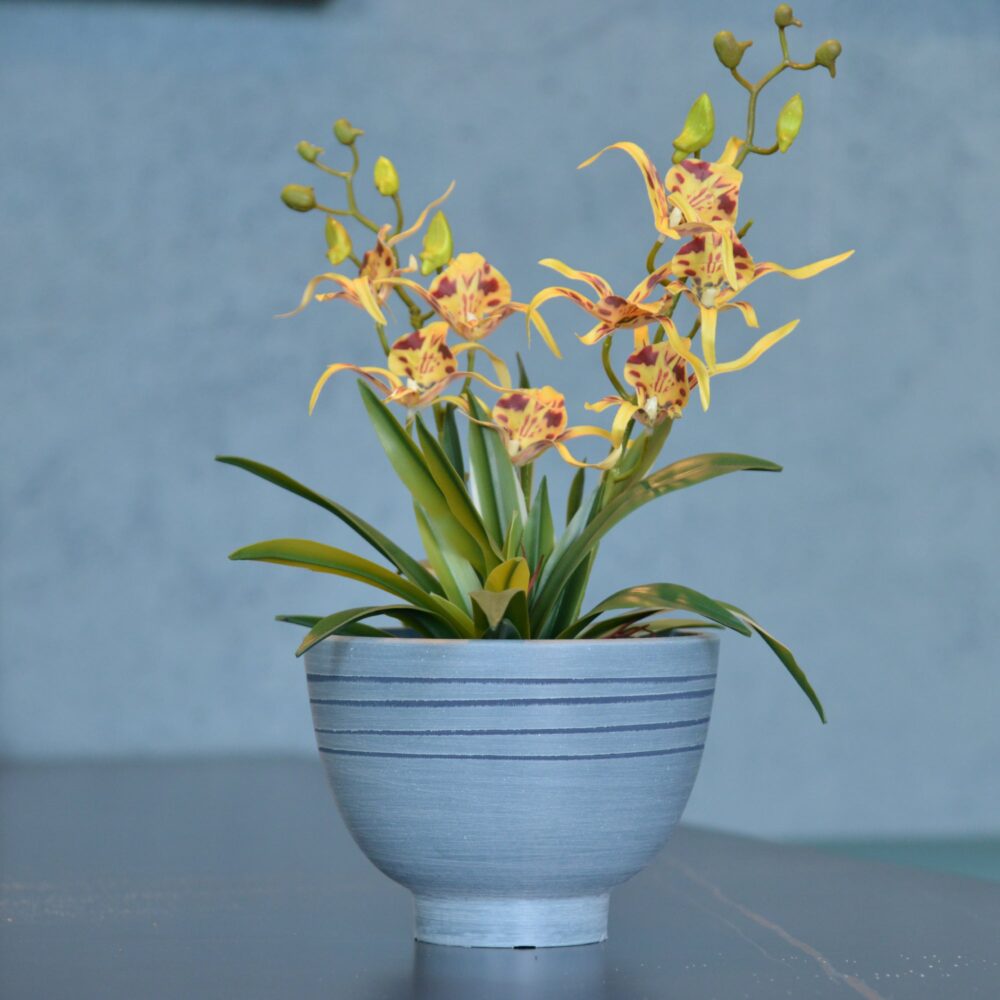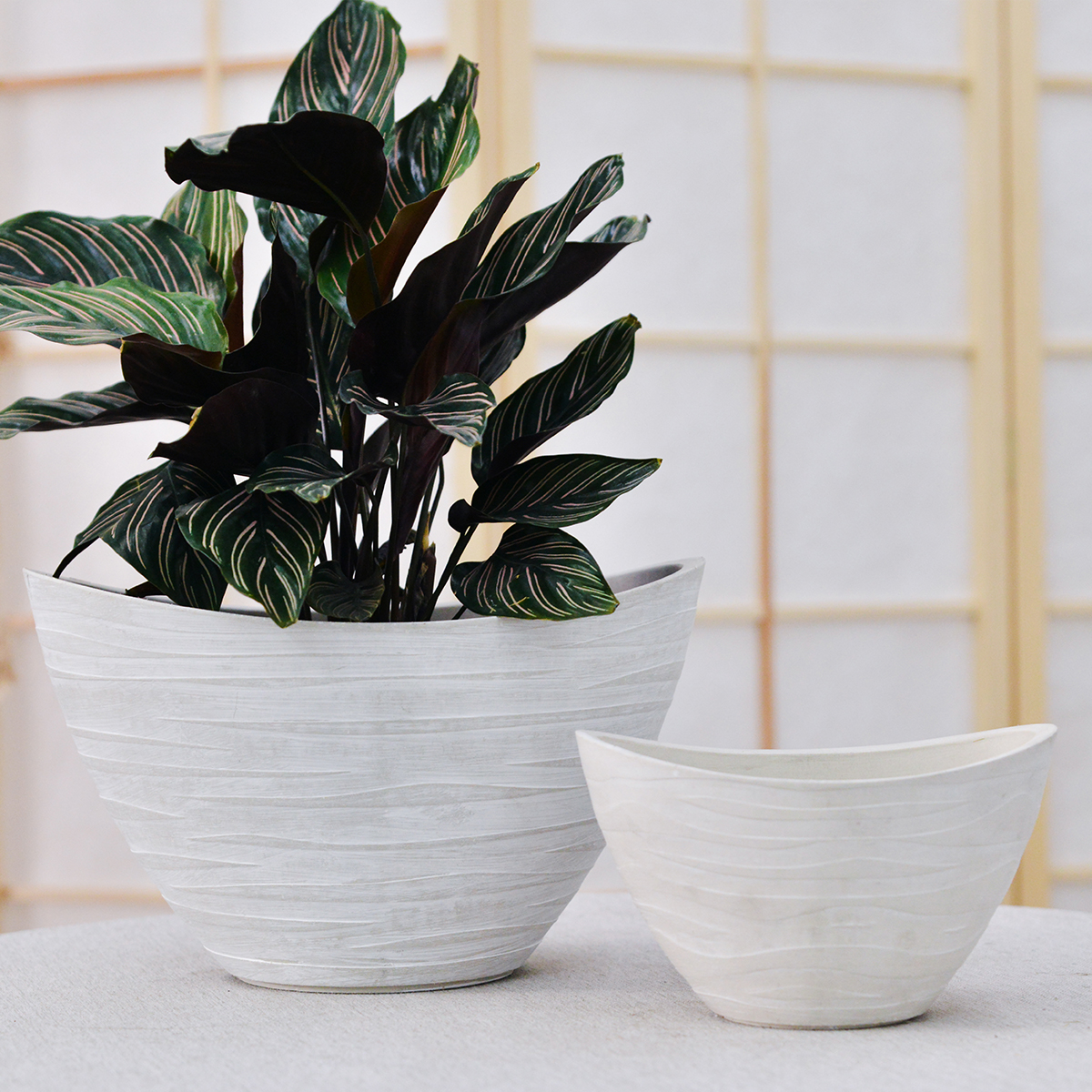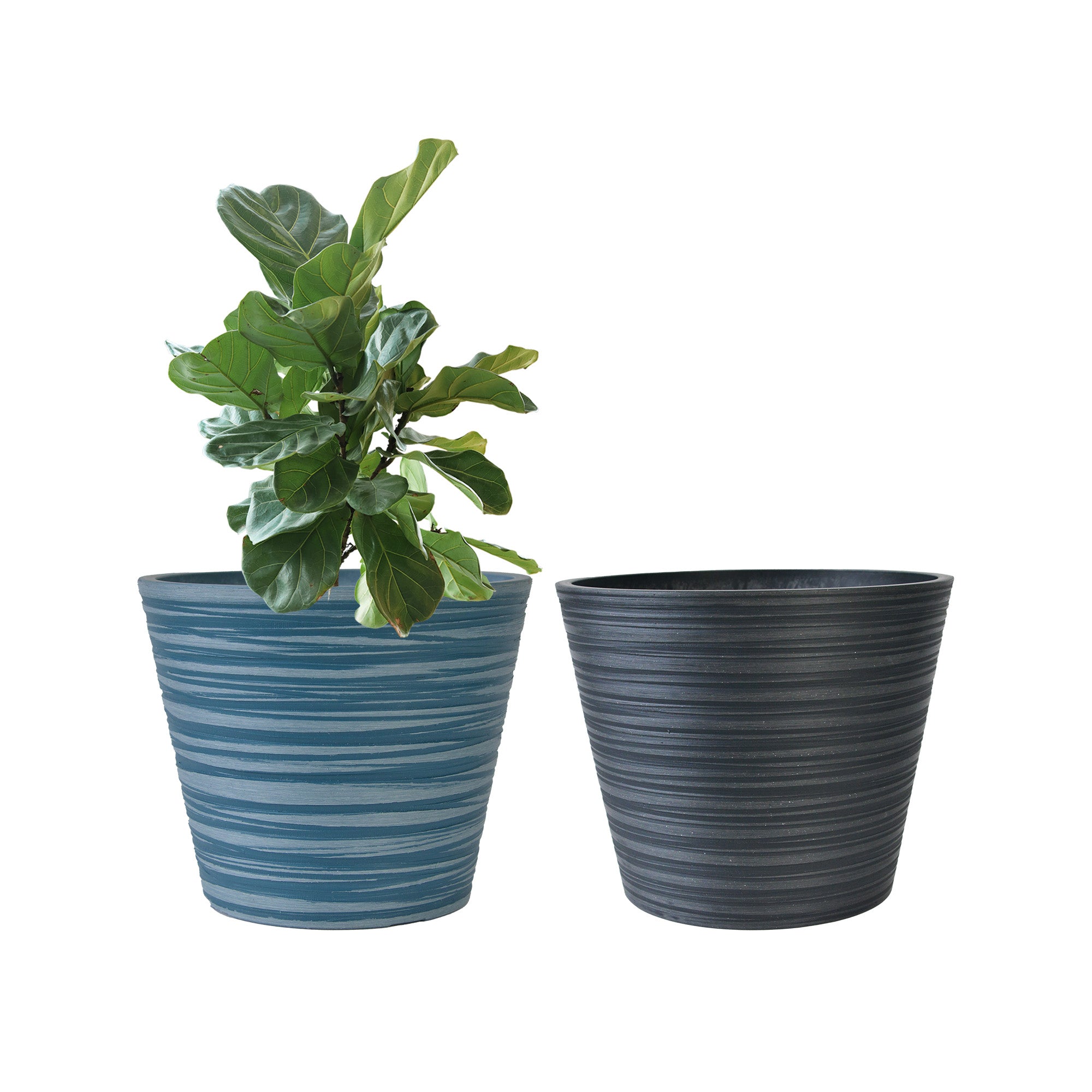Calla Lilies in Pots: The Complete Guide to Growing Calla Lilies Outdoors in Containers (Elegant & Easy!)
Want to add a touch of sophisticated elegance and graceful beauty to your patio, balcony, or garden? Growing Calla Lilies (Zantedeschia) in containers is a wonderfully rewarding and surprisingly easy way to bring these iconic flowers into your outdoor spaces. Celebrated for their elegant, trumpet-shaped spathes in a range of colors, their lush, arrow-shaped foliage, their relatively long blooming season, and their adaptability to container gardening, Calla Lilies are perfect for adding a touch of refined beauty and modern flair to your outdoor living areas. This comprehensive guide will provide you with everything you need to know to grow Calla Lilies successfully in outdoor pots, from selecting the best varieties and containers to mastering essential care techniques for a stunning and long-lasting floral display.
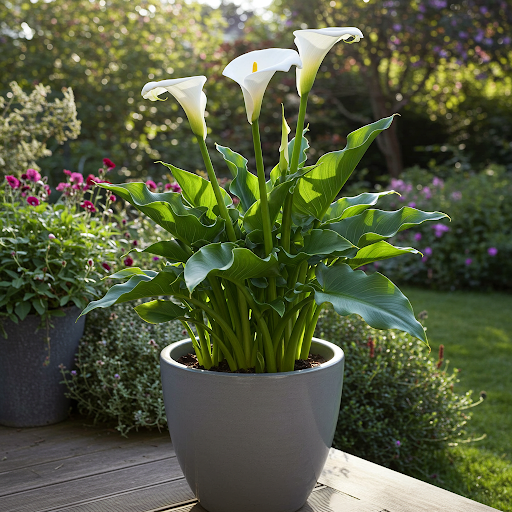
Calla Lilies
What are Calla Lilies?
Calla Lilies, scientifically known as Zantedeschia, are elegant herbaceous perennials belonging to the Araceae family (Arum family). Native to southern Africa, they are widely cultivated as ornamental plants around the world, prized for their distinctive, trumpet-shaped flowers (actually spathes), attractive foliage, relative ease of care, and versatility in garden and container design. Calla Lily plants are characterized by their smooth, spear-shaped or arrow-shaped leaves, arising from rhizomes or tubers, and their elegant flowers that consist of a prominent spadix (a central, finger-like flower spike) surrounded by a large, showy spathe (a modified leaf that resembles a petal). The spathe is the colorful, trumpet-shaped part that is commonly referred to as the “flower” and comes in a wide range of colors, including white, yellow, orange, pink, red, purple, and dark burgundy/black. They exhibit a clump-forming, upright growth habit, typically reaching heights of 1-3 feet depending on the variety, and are known for their refined elegance, long vase life as cut flowers, and adaptability to both garden beds and container culture. Despite their common name, they are not true lilies (Lilium) but are related to plants like Arum Lilies and Elephant Ears.
Are Calla Lilies Good for Outdoor Pots?
Yes, Calla Lilies are exceptionally well-suited for outdoor pots and container gardening, and are a popular choice for adding sophisticated beauty and architectural foliage to patios, balconies, and other outdoor areas. Their manageable size, upright growth habit, elegant flowers, and adaptability to pot culture make them ideal for container cultivation. Growing Calla Lilies in pots offers several advantages:
- Ideal for Patios and Balconies: Container gardening allows you to enjoy Calla Lilies even if you have limited garden space, such as on balconies, patios, or decks. They bring a touch of modern elegance to paved areas.
- Portability: Potted Calla Lilies can be easily moved to optimal locations for sunlight, display, or shelter from extreme weather. You can rearrange them to create stunning focal points or seasonal displays. Bring them indoors to protect from frost in colder climates.
- Controlled Environment: Container gardening allows you to provide the specific well-draining, moisture-retentive soil mix that Calla Lilies prefer and control watering and fertilization more precisely, which is important for their health and flowering.
- Design Versatility: Calla Lilies in pots can be used as standalone specimen plants in decorative pots, grouped together for a massed display, or incorporated into mixed container arrangements with other plants. Their upright form and elegant flowers add structure and sophistication to container gardens.
- Pest and Disease Management: Container growing can help reduce some soilborne pest and disease issues that can affect Calla Lilies planted directly in the ground.
- Water Feature Compatibility: Potted Calla Lilies can be placed near water features, ponds, or even in bog gardens in containers, as some types (especially Zantedeschia aethiopica) tolerate or even prefer consistently moist to wet conditions.
- Bringing Indoors for Winter (in colder climates): In regions with colder winters, Calla Lilies are not reliably hardy. Growing them in pots makes it easy to move them indoors to a cool, frost-free location for the dormant winter period, protecting the rhizomes or tubers and ensuring their return the following spring. (Less relevant in Singapore’s climate, but portability is still useful for other reasons).
Ideal Growing Conditions for Calla Lilies in Pots:
Types of Calla Lilies for Pots: While most Calla Lilies can be grown in containers, some types are particularly well-suited:
- Dwarf or Compact Calla Lily Varieties: Look for varieties described as “dwarf,” “compact,” or “patio-sized.” These are bred to be smaller and more manageable in pots. Examples include ‘Summer Sun’, ‘Mango Zest’, ‘Pink Melody’, ‘Picasso’, ‘Little John’, ‘Black Forest’.
- Colored Calla Lilies (Hybrids): Colored hybrids (often Zantedeschia elliottiana hybrids or Zantedeschia rehmannii hybrids) tend to be slightly smaller and often more floriferous than the larger white Zantedeschia aethiopica. They come in a wide range of colors (yellow, orange, pink, red, purple, etc.) and are excellent for containers.
- Zantedeschia aethiopica ‘Crowborough’ (and similar hardy varieties): If you want to grow white Calla Lilies in pots outdoors, choose hardy varieties of Zantedeschia aethiopica like ‘Crowborough’ which are more tolerant of cooler temperatures and can even handle slightly boggy conditions. However, they can be larger and may need bigger pots.
- Consider Flower Color and Height: Choose varieties based on your preferred flower color, bloom time (early, mid, late season), and mature plant height to suit your container size and garden design.
Light: Calla Lilies thrive in full sun to partial shade. They appreciate at least 6 hours of sunlight per day for best flowering, especially the colored hybrids. White Calla Lilies (Zantedeschia aethiopica) can tolerate more shade and may even prefer partial shade in hot climates. When grown in pots outdoors, position them in a location that receives morning sun and afternoon shade, or dappled sunlight throughout the day. Avoid very harsh, intense afternoon sun, especially in hotter climates, as this can scorch leaves and fade flower colors. Bright, indirect light or filtered sun is ideal. Too much shade can reduce flowering.
Soil: Calla Lilies need well-draining soil that is also moisture-retentive and rich in organic matter. Use a high-quality potting mix specifically formulated for контейнер plants or flowering plants. Amend potting mix with compost, well-rotted manure, peat moss or coco coir, and perlite or vermiculite to improve fertility, drainage, water retention, and aeration. Good drainage is essential to prevent root rot, but Calla Lilies also appreciate consistent moisture, so the soil should not dry out too quickly. A slightly acidic to neutral pH (around 6.0-7.0) is ideal.
Watering: Calla Lilies prefer consistently moist soil during their active growing and blooming season, but they don’t want to be waterlogged (except for Z. aethiopica which tolerates wetter conditions). Water thoroughly when the top inch of soil feels slightly dry. Water deeply until water drains out of the drainage holes. Then, allow the topsoil to slightly dry before watering again. Avoid overwatering and consistently soggy soil, which can lead to root rot. Also, avoid letting the soil dry out completely, especially when plants are actively growing and blooming. Calla Lilies prefer a “moist but not soggy” soil environment. Watering frequency will depend on weather conditions, light levels, and pot size. Water more frequently during warmer, drier periods and less frequently during cooler, cloudier periods. Reduce watering significantly in the dormant season (after flowering, typically in late summer and fall). Allow the soil to become drier during dormancy, but don’t let the rhizomes/tubers dry out completely.
Temperature: Calla Lilies thrive in warm temperatures, ideally between 60-80°F (15-27°C) during the growing season. They are frost-tender and should be protected from freezing temperatures. In Singapore’s consistently warm climate, temperature is generally ideal for Calla Lilies year-round. They can tolerate high heat, but may appreciate some afternoon shade in very hot climates to prevent leaf scorch. Consistent warm temperatures are beneficial for their growth and flowering.
Humidity: Calla Lilies prefer moderate to high humidity, reflecting their subtropical origins. Singapore’s humidity is generally well-suited to Calla Lilies. They appreciate humidity and good air circulation.
Fertilizer: Calla Lilies are moderate feeders and benefit from regular fertilization during the active growing and blooming season to support healthy growth and abundant flowering. Fertilize every 2-4 weeks during the spring and summer growing season. Use a balanced liquid fertilizer (e.g., 20-20-20 or 10-10-10) diluted to half strength, or a fertilizer specifically formulated for flowering plants or bulbs. Follow product label instructions for application rates. A fertilizer slightly higher in phosphorus (the middle number) can encourage better flowering. Reduce or stop fertilizing during the dormant season (late summer and fall) when plant growth naturally slows down.
Choosing the Right Pots for Calla Lilies:
Suitable Pot Types: Calla Lilies can be grown in various pot types, but good drainage and appropriate size are important. Suitable pot types include:
- Terracotta Pots: Terracotta is a good choice as it provides excellent drainage and aeration, helping to prevent overwatering, and offers a classic, elegant look that complements Calla Lilies. Larger terracotta pots are recommended for stability and for larger clumps of Calla Lilies.
- Ceramic Pots: Glazed or unglazed ceramic pots can be used, offering a wide range of decorative styles. Ensure they have drainage holes and are sturdy enough for the plant size. Choose based on your desired aesthetic and stability needs.
- Resin Pots: Lightweight, durable, available in styles mimicking terracotta or ceramic, and offer a balance of drainage and moisture retention. Resin pots are a good alternative to heavy terracotta or ceramic, and often more durable than terracotta or plastic. Choose sturdy resin pots.
- Plastic Pots (Sturdy): Sturdy, good quality plastic pots can be used, especially for larger plants, as they are lightweight and durable. Ensure excellent drainage and be careful not to overwater in plastic pots as they retain moisture. Dark-colored plastic pots can heat up excessively in full sun in hot climates, so lighter colors or shading the pot may be preferable.
Drainage: Good drainage is essential for Calla Lilies to prevent root rot. Ensure your chosen pot has drainage holes at the bottom. Avoid pots without drainage holes. Always use a drainage layer at the base of the pot (e.g., a layer of gravel or pot shards) beneath the potting mix to further enhance drainage. Elevating pots slightly on pot feet or bricks can also improve drainage and air circulation.
Pot Size: Choose pot sizes appropriate for the size and type of Calla Lily and your desired display. Calla Lilies grow from rhizomes or tubers and need room for root development and clump expansion.
- Individual Calla Lily Rhizome/Tuber: Start with a pot that is at least 8-10 inches in diameter and depth for a single rhizome or tuber.
- Clumps of Calla Lilies (or larger varieties): Use pots that are 12-16 inches in diameter and depth or largerfor clumps of Calla Lilies or for larger varieties like Zantedeschia aethiopica.
- Larger Displays: For massed container plantings or larger displays, use pots that are 18-24 inches in diameter or larger. The larger the pot, the more rhizomes/tubers you can plant and the more impressive the display.
- Depth: Pots should be at least 8-12 inches deep, and ideally 12-16 inches deep or more for larger varieties, to accommodate the root system and rhizome/tuber development.
Stability: Calla Lilies are generally not very top-heavy, but using moderately heavy pots (terracotta or ceramic) can provide good stability, especially for larger, mature clumps or if placed in slightly windy locations. Wider pots are generally more stable than tall, narrow pots.
Color and Style: Choose pot colors and styles that complement the flower colors and elegant form of your Calla Lilies and your outdoor décor, and enhance their sophisticated, modern appearance. White, cream, gray, black, or metallic-toned pots can create a chic and contemporary look, highlighting the elegant lines of the Calla Lily spathes. Earthy tones like terracotta or muted greens can create a more natural, classic feel. Consider the overall style of your patio or balcony and choose pots that harmonize with the surroundings and enhance the desired elegant, modern garden ambiance.
Essential Care Tips for Thriving Calla Lilies in Outdoor Pots:
- Watering: “Keep Soil Moist During Growing Season, Drier During Dormancy”. Water thoroughly when the top inch of soil is slightly dry during the growing season (spring/summer). Water deeply and ensure good drainage. Allow topsoil to slightly dry between waterings. Reduce watering significantly during dormancy (late summer/fall).
- Sunlight: Provide Full Sun to Partial Shade (at least 6 Hours of Sun for Best Bloom). Place Calla Lily pots in a location with full sun to partial shade outdoors. Protect from harsh afternoon sun in hot climates. Bright, indirect light is also suitable.
- Fertilizing: Fertilize Every 2-4 Weeks During Growing Season with Balanced Liquid Fertilizer. Fertilize regularly during the spring and summer growing season to promote healthy growth and flowering. Use a balanced liquid fertilizer or bulb fertilizer. Reduce or stop fertilizing during dormancy.
- Deadheading (Optional, for Neatness and Rebloom): Deadheading spent flowers (removing faded spathes and seed pods) is not strictly necessary, but it can improve the plant’s appearance and may encourage more blooms in some varieties by preventing seed formation. Cut spent flower stalks at the base.
- Dormancy Period (Drier Rest in Fall/Winter): Calla Lilies typically have a dormant period after flowering, usually in late summer or fall. During dormancy, foliage may start to die back. Reduce watering significantly and allow the soil to become drier. In colder climates where Calla Lilies are not hardy, you can lift the rhizomes/tubers from pots and store them in a cool, dry, dark place over winter before replanting in spring. In Singapore’s climate, dormancy is less pronounced, but a drier rest period after flowering is still beneficial.
- Repotting (Every 2-3 Years or When Overcrowded): Repot Calla Lilies every 2-3 years or when they become overcrowded in their pots. Repot in spring, just as new growth begins. Divide rhizomes/tubers if desired when repotting to propagate new plants.
- Pest and Disease Control: Calla Lilies are relatively pest and disease resistant. Monitor for common pests like aphids or spider mites, though they are not usually a major problem outdoors. Root rot is the most common disease issue, caused by overwatering. Prevent root rot by ensuring excellent drainage and proper watering practices.
Popular Calla Lily Cultivars (and Spathe Colors):
Calla Lily cultivars are available in a stunning array of spathe colors, sizes, and forms beyond the classic white.
- White Calla Lilies: ‘White Giant’ (Z. aethiopica hybrid, large white), ‘Crowborough’ (Z. aethiopica, hardy white), ‘Alba’ (classic white).
- Yellow Calla Lilies: ‘Yellow Sun’, ‘Gold Medal’, ‘Lemon Drop’, ‘Mango Zest’ (apricot-yellow).
- Orange Calla Lilies: ‘Flame’, ‘Apricot Brandy’, ‘Captain Promise’ (peach-orange).
- Pink Calla Lilies: ‘Pink Perfection’, ‘Pink Melody’, ‘Rose Queen’, ‘Strawberry Swirl’.
- Red Calla Lilies: ‘Red Alert’, ‘Rubylite’, ‘Hot Shot’.
- Purple/Lavender Calla Lilies: ‘Lavender Gem’, ‘Purple Rain’, ‘Royal Purple’.
- Dark Burgundy/Black Calla Lilies: ‘Black Magic’, ‘Schwarzwalder’, ‘Dark Desire’.
- Bi-Color Calla Lilies: ‘Picasso’ (white with purple throat), ‘Galaxy’ (yellow and red), ‘Strawberry Blush’ (pink and white).
In Summary:
Growing Calla Lilies (Zantedeschia) in outdoor pots is a wonderfully rewarding and surprisingly easy way to add a touch of sophisticated elegance and graceful beauty to your patio, balcony, or garden. Their iconic, trumpet-shaped spathes, lush foliage, and adaptability to containers make them a perfect choice for container gardeners of all levels, especially those seeking refined, low-maintenance color for their outdoor spaces. By providing full sun to partial shade, well-draining, moisture-retentive potting mix in pots with good drainage, keeping the soil consistently moist during the growing season but drier during dormancy, regular fertilizing during spring and summer, and choosing pot sizes appropriate for the variety, you can easily cultivate thriving and spectacularly blooming Calla Lily plants in pots and enjoy their elegant floral display in your outdoor living spaces year after year.
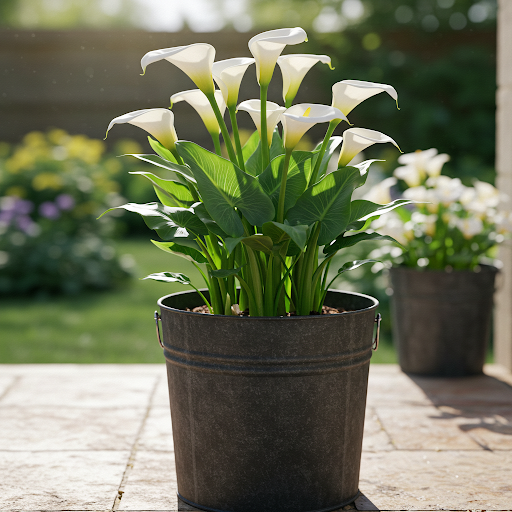
Calla Lilies
For more detailed botanical information and to explore the diverse world of Zantedeschia (Calla Lily), you can visit the Wikipedia page on Zantedeschia.
Important Note: Calla Lilies are relatively easy to grow in pots if you provide them with consistently moist soil during the growing season, good drainage to prevent root rot, and a period of drier dormancy after flowering. With proper care and a suitable location, your potted Calla Lilies will reward you with years of elegant foliage and stunning, sophisticated blooms!
20VD
By greenship|2024-08-13T06:43:41+00:00August 13, 2024|Categories: Hand-carving Series|
8 inch/10 inch Planter Indoor Plants, 2 Pack Modern Decorative Plant Pots with Drainage Hole, Cute Bowl Shape Flower Pots
By greenship-seo|2025-04-10T08:03:42+00:00January 9, 2025|Categories: Hand-carving Series|Tags: Decorative Flower Pots, Self-Watering Pots|
20YB
By greenship|2024-08-16T05:37:57+00:00August 16, 2024|Categories: Hand-carving Series|
KC2-11V
By greenship|2024-08-16T05:39:50+00:00August 16, 2024|Categories: Hand-carving Series|
Planter 5 in W / 8 in W / 12 in W or Indoor Outdoor Plants, Modern Decorative Plant Pots with Drainage Hole, Decorative Flower Pots
By greenship-seo|2025-04-10T06:37:58+00:00January 16, 2025|Categories: Hand-carving Series|Tags: Decorative Flower Pots|
k2-21G
By greenship|2024-08-13T06:17:26+00:00August 13, 2024|Categories: Hand-carving Series|


